Best of Reaktor User Library january 2.017
Blocks
DrumBurst Patch
by Paule Amca
Ethno Bechain with 3 Blocks
Bechain by David Elson
Axis, Dual LFO and Dual Lat Chaos by Brett Lavallee
Bank 5 and 6 by David Coffin
Add samplemaps DrumBurst and bank 7
***
he morph
by Paule Amca
based on he is here by LazyfiSh
4 ambience blocks and the reverb driven by morph 4in2
***
SB Blooper
by Stephan Bobinger
Droner, Noise, Synth Blocks Patch
Makes Drones & Noises and some fun background stuff.
Used Block:
SA Offscillator
Neon
Bento Box Vca
SA OK Auto Pan
SA OK Reverb
SA EZ-Scope
Have fun droning and check my soundcloud for some real Tracks of mine
https://soundcloud.com/stephan-bobinger
https://www.facebook.com/stephan.bobinger
***
Samplers
Bechain
by david elson
Bechain:
Four one shot samplers
Four pattern sequencers
And some nice stuff:
Individual sequence length, shuffle, decay and randomisation
plus
selectable on the B-Panel:
Multiple outputs
MIDI note out
V 1.0.1 - put the multiple outputs in as i had forgotten to connect them + d.coffin's presets sorted
Use for quick and dirty drum programming....
Samples by Puremagnetik
Presets by Brett Lavallee and David Coffin
***
Bechain.1. Automatic 1
by David Coffin
Automating Bechain
With de's blessing, herewith one way of adding automation to his delightful Bechain using standard factory step LFOs. Since these were all added after the many snaps that come with the standard version, one can activate the automation on those snaps or not simply by visiting the Automatic Bank and selecting from (and adding to) the Master snaps that do include the LFOs—including All Off of course—and then return to the other banks where every new selection will now be run through whatever Automatic choice you've made. Any new Master snaps you save anywhere will include the LFO settings, so I'd suggest creating a new bank for these, so the existing banks remain uniformly agnostic about Automation…if you're an orderly sort, that is.
The Position sliders I've added to the Sample and Pattern LFOs are a bungled attempt to access more of the xy fields than a right-rising diagonal, such as an option for a left-rising diagonal; perhaps some better-informed soul will show me how to do that? I left 'em in because they do SOMEthing which adds interest, esp. if they themselves are made to move around.
***
PolyBiff 0.6
by david elson
euclidean percussion sampler featuring dual euclidean sequencers, each with granular sampler
euclidean stuff:
Martin Wood-Pitrovski, Benjamin Kilchhofer and someone lost....
samples:
http://www.everythingturns.com/
there is a bug
visualisation does not always display the number of hits correctly
don't know why...
v0.6 added MIDI out
***
Sample Mangler
by Siddharth Dubey
The -over the top- Reaktor instrument, It will read a wav sample and will let you play with read speed, SR reduction, grain delay, frequency division and more.
***
Snapshots
Auralis 3.4 Bank - Variations on Vadleany
by Bart Luyckx
Based on the Vadleany preset, I mutated around a bit and came up with these.
***
Snaps for Maybelogue
by David Coffin
Loving Maybelogue Sequences, from brice beasley, here: https://www.native-instruments.com/fr/reaktor-community/reaktor-user-library/entry/show/10477/
Added a bank of my noodlings with it; thank you brice, for a lovely afternoon!
****
UPDATE, now 2 banks; amazing device!
****
I did link up some mods to the Bento 8-Steps, as shown in the screen-grab, after a while; hardly any of these snaps use them, but you might want to try doing that, too—makes for considerably less repetitive note sequences, if that's of interest.
***
Trend Setters
by Brett Lavallee
20 Futuristic sounds for Leadster type E.
This is a great synth that uses a unique approach to achieve sounds never heard before.
My favorite features are the oscillators, which can have their tones modulated in a variety of creative ways. They are set to harmonic intervals which can also be modulated, resulting in interesting evolutions or sequenced patches.
The modulation sources are great as well, especially the step sequencer and the morph module, which can act like either an envelope or LFO, depending on its configuration.
These presets attempt to highlight some of these features, and hopefully they will spark some routing ideas of your own. They include a variety of pads and leads.
***
Synthesizers
BRUTE
by Nick Dwyer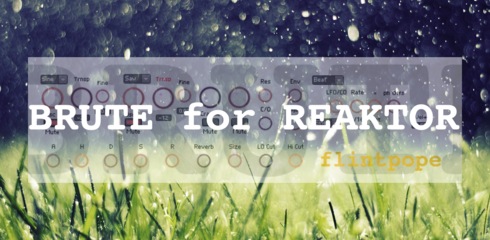
Reaktorblocks is fun, but I thought it was time for me to go further and create an instrument in Reaktor’s Primary as it lends itself to greater flexibility in sound and look; let me introduce BRUTE for REAKTOR 6
This simple polyphonic subtractive synth gives you a set of punchy drums, some powerful basses and a range of interesting sounds for top-lines. I didn’t preset lots of strings and pads but they are easily created.
Two oscillators with four wave-forms in each and a powerful LFO combine to give an interesting depth and variation. Extra sound sources are crackle and hiss so it’s also possible to get that LOFI retro-sampled feel.
***
CetoneBass2
by René Jeschke
Monophonic bass and lead synthesizer with loads of modulation possibilities.
Features:
- two unique oscillators with eight different waveforms, hard sync and ring modulation
- 24dB multimode ladder filter
***
CetoneWaves
by René Jeschke
Three oscillator wavetable synthesizer.
Drop your wavetables into the sample map and start tweaking. Wavetable format is 2048 samples per wave and up to 256 waves per table, so Serum wavetables should work fine. Don't forget to press the WT-Map->Update button to update the oscillators with the changed sample map.
There are only a handful of wavetables included, as all the others on my harddisk might not be suitable for redistribution.
Features:
- 3 bandlimited wavetable oscillators with cycle-crossfade and ring modulation on oscillator #1
- 24dB multimode filter with ladder response
- 2 LFOs, 2 modulation envelopes and 8 modulation slots
***
DrumBurst Bechain Automatic
by David Coffin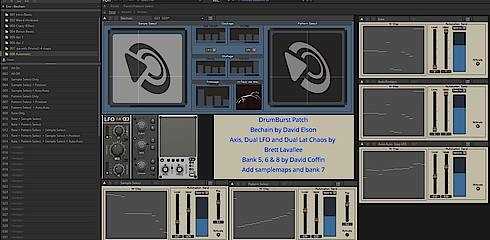
Seems an obvious thing to do:) Thanks Paule for the cool new samples'n'all!
***
Hilter Pad
by Kurt Olsson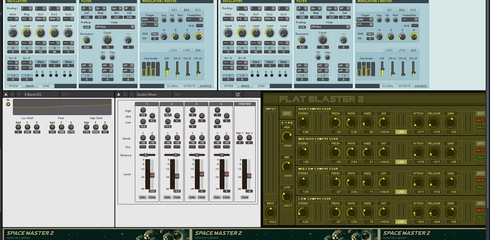
Using two Carbon2 synthesizers, one panned slight left and one panned slight right, this ensemble sounds major, mega, and massively rich. All three OSC's are used in each synth with one synth having slight (+) detune and the other with slight (-) detune: only OSC2 is the same in both synths. The result of these 5 differently pitched OSC's is the heart of Hilter Pad. Both synths use "in house" chorus but just enough. After both Carbon2 synths are given mid to upper EQ boost then into a Space Master 2 for ample reverb. The caboose in this train is a Flat Blaster 2.
1.1 UPDATE - for whatever reason the third OSC in both Carbon2 synths was disabled. Plus detuned OSC's were not as intended previously. This update is what was intended as released before.
***
Hyroglyphicus Synth 2.2 (R5)
by michael o'hagan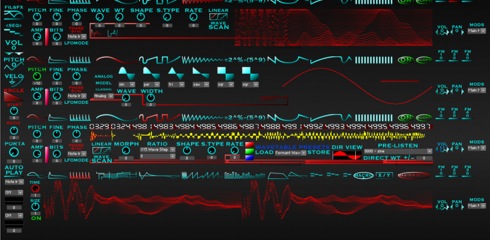
Hyroglyphicus Updated to Version 2.2 on January 13th 2017
A Few internal improvements and some bug fixes
This is the final Reaktor 5 compatible version
***
Hyroglyphicus Synth Finale 2.5 (R6)
by michael o'hagan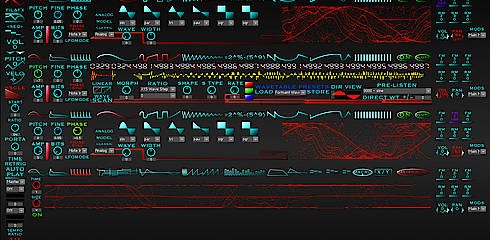
Hyroglyphicus V2.5 for Reaktor 6 Updated January 13th 2017
Synth now contains the following new filters from R6 blocks.
Requires Reaktor 6.1
Monark MM
Monark LP2
Monark LP1
Monark BP
Vodka
Morphine
Grobian ZDF
EPS+FX
Bento Box
Comber X2
***
LEADSTER typeE
by Apoidea Instruments
LEADSTER type E is the synthesizer starting from creating the waveform. It is completely different from the method of selecting a waveform.
Compared to type C, I have greatly enhanced the modulation function and improved expressiveness.
Version 1.0 - First public
Version 1.1 - Improved CPU usage
Additional presets : Trend Setters
https://www.native-instruments.com/jp/reaktor-community/reaktor-user-library/entry/show/10817/
Special thanks to Brett Lavallee.
***
MP-30
by Jonathan Tremblay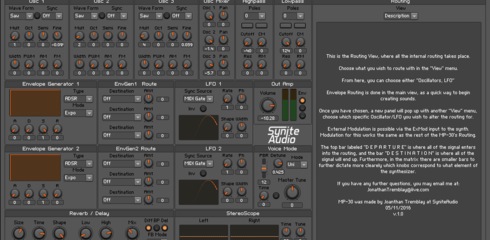
MP-30 is a multiphonic instrument capable of: Mono, Poly, and Unison
It is a simple synth with powerful sonic capabilities, as well as a great learning tool for various methods of synthesis. Originally made back when I still had R5 and didn't own a computer good enough to run R6, but I thought it would be great to bring back as I'm more focused into my blocks collection. However I might make more instruments should I have the creative ideas to do so.
Included is the Ensemble and Instrument
Also additional snaps which have been incorporated to their phonic categories by:
Brette Lavallee
v.1.3 Snapshots (2017/01/18)
-ADDED: Enough snaps to each bank to total 20 per bank, except for the INIT bank
Below is the description for function:
__How To Use (EnvGen Route)__
The Envelope Generator Router (EnvGen Router), is used to send the associating Envelope Generator's signal to various destinations, and is placed right into the synth for quick and easy access to start routing from the get-go.
Each Router has it's own Multi-Envelope Generator, and 3 destinations each, allowing modulation of up to 6 parameters at once.
__How To Use (Routing)__
Please refer to the description of this particular section under the "Description" option of the Routing view menu on the B-Side.
__How To Use (ExMod)__
Short for "External Modulation"
Please refer to the description of this particular section under the "Description" option of the Routing view menu on the B-Side.
__How To Use (ExSync)__
This input is used to send a sync signal, either to LFO 1 (ExSnc1) or LFO 2 (ExSnc2). After properly connecting your sync signal to the in port, go to which ever LFO you want to sync and change it's "Sync Source" to "External"
***
rachToy XY v3-Broken
by David Coffin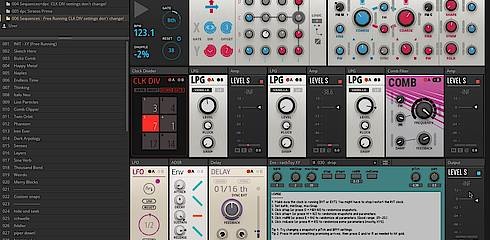
Found this recently in my vast downloads collection (MUCH bigger than the UL itself considering all the dups and resaves), loved it… and then I accidentally broke it in a way that seems pretty cool, described below at *^*
In the meantime, here's a long explanation for HOW I broke it which you can certainly skip over: As I messed around with all the cool randomization tools, I started wanting to be a little less random with it, so I started to precisely reconfigure just specific blocks and saving stuff. Then I found I couldn't save snaps to the Clock Divider block, which is often an easy target for sometimes totally, and often interestingly, reconfiguring a Master Snap you particularly like. Started a forum thread about fixing this in general, heard it was a bug, but got some suggested workarounds, which led to dragging in a new copy of that block from the Factory collection, which fixed the snap saving BUT also converted the 2 banks of original snaps so that they wouldn't change CLK DIV settings when switched between, something to do maybe with device ID's but I couldn't get it to work right. This seemed a great shame…UNTIL I heard of another fix for snap-crippled blocks (see thread here: https://www.native-instruments.com/forum/threads/cant-create-snaps-for-some-blocks.313784/#post-1555645), and tried that on the original download, which worked great WITHOUT wrecking the original rachMiel snaps. THEN I discovered that if I saved out the broken snap banks from my failed-fix version of the ensemble and loaded them into new banks in the fixed original, the snaps in these banks STILL wouldn't change CLK DIV setting at all, but you could load in a new snap for the CL DIV into any one of them, and those settings would hold whenever you switched to a new snap in that bank. Just as if the CLK DIV was snap isolated…but it's NOT in any of the other banks.
*^* The Good Part:
Two copied banks from the original upload all of whose snaps have the Clock Divider snap isolated, but NOT at the Property level, at the bank level. Plus a few CLK DIV snaps you can load into these banks to reconfigure the whole bank. And you can save more, assuming the bug doesn't reappear now that this iteration already has some banks.
***
SIX-O-SONIC
by Howie Ross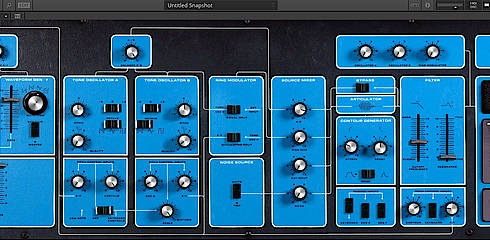
This is my take on a rare monophonic synth from the 70s from that famous company everybody knows. It came in a black suitcase and some people say it is the perfect educational synthesizer. Actually its creator (known as „the Godfather of Modern Synthesis“) commonly used it to demonstrate the capabilities of his company in public.
What made me want to do this Ensemble was
a) I probably could not afford to buy a real vintage one
b) This synth has some tricks up its sleeve which makes it so very special
This is my first contribution to the library -and I must thank a lot of people who have uploaded fantastic stuff here before me. I only was able to get this done because I was "standing on the shoulder of giants".
At first sight it is your basic two oscillator and one low-pass filter buddy which has one envelope – which makes it looks limited.
But as soon as you understand how the two (!) LFOs can be mixed and used to trigger the envelope or modulate the filter and the oscillators you are in experimental polyrhythmic heaven.
Then there is a ring modulator and at the same time OSC A can be used to modulate OSC B.Whew!
Where it also becomes interesting is the Pitch control. When you swich it to „Low Note“ OSC A and Diatonic on OSC B you have true duophony. Any setting lower than Diatonic will result in OSC B not following the keyboard completeyl so you can play quarter pitched notes or more weird stuff.
The design of the interface to me is just as important as the technical background. I wanted it to look as real as possible to get a hold oft he joy it makes to fiddle with knobs on old analogue gear.
I had to make just one compromise on the LFOs where the role model had a „Click switch“ when you turned it fully counter clockwise. With that GEN X and GEN Y would independently modulate OSC A and OSC B. I replaced it with a standard on/off switch.
I have added some absolutely non-standard presets as well as this sound example which was completely made up by the Six-O-Sonic (9 instances). Just shos this is all you need to make a Synth Pop classic ;-)
I strongly recommend that you look up the original manual from the 70s for this synth on the internet and visit this page by Gordon Reid for some more funky information on this fantastic piece of gear (https://www.gordonreid.co.uk/vintage/sonic6.html)
Have much fun with it and let me know what you think. As said in the beginning I unfortunatley do not own the original hardware and so settings may vary.
P.S. :Future development might include tempo sync to host
***
